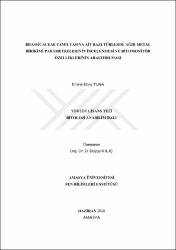| dc.contributor.advisor | Kılıç, Dudu Duygu | |
| dc.contributor.author | Tuna, Emine Ebru | |
| dc.date.accessioned | 2022-03-09T14:56:11Z | |
| dc.date.available | 2022-03-09T14:56:11Z | |
| dc.date.issued | 2018 | |
| dc.identifier.uri | https://tez.yok.gov.tr/UlusalTezMerkezi/TezGoster?key=hcgrYffRbz0Z44UJEuLtwY0fJEuefstYZEoEhmg75sl-K_fnrUPyFx-B0Tjc5vyp | |
| dc.identifier.uri | https://hdl.handle.net/20.500.12450/1860 | |
| dc.description.abstract | Atmosferde, su ve toprakta ağır metal derişiminin kritik değerlerin üzerinde olması bütün canlı organizmalar için büyük bir tehlikedir. Ağır metal derişimlerinin yüksek seviyede olması toprak kalitesinde bozulmaya, ürün verim ve kalitesinde azalmaya neden olmakta dolayısıyla insanlar ile diğer tüm canlı organizmalar için önemli tehlikelere yol açmaktadır. Ağır metal kirliliğinin sadece toprak kalitesi üzerine değil besin zinciri yoluyla hayvan ve insan sağlığı üzerinde de pek çok olumsuz etkileri olduğu bilinmektedir. Bu nedenle çevresel ve biyolojik örneklerdeki metal ve metal bileşiklerinin derişimlerini belirlemek ve kontrol altında tutmak oldukça önemlidir. Çevresel ve biyolojik numunelerdeki ağır metal derişiminin belirlenmesi ve kontrolü için değişik yöntemler kullanılmaktadır. Belirli metal türleri için seçicilik ve akümülatör özellik gösteren bitki türlerinin kullanılması da bu yöntemlerden birisidir. Çalışma materyali olarak, Amasya ilinden geçen karayolu boyunca doğal olarak yayılış gösteren Brassicaceae familyasına ait, Calepina irregularis, Capsella bursa-pastoris, Lepidium draba, Sisymbrium loeselii ve Sisymbrium altissimum türleri seçilmiştir. Çalışmada Amasya ilinde şehiriçi, yol kenarı, kenar semt ve kontrol bölgesi olmak üzere her birinden 4 farklı lokalitede yürütülmüştür. Türlerin kök, gövde ve yapraklarında ağır metal ( Cr,Pb,Zn,Cu,Cd ) birikimi miktarları İndüktif Eşleşmiş Plazma-Optik Emisyon Spektrometri (ICP-OES) ile belirlenmiştir. Farklı istasyonlar arasındaki sonuçlar istatistikî testlere tabi tutularak çalışılan bitkilerin metaller için biyomonitör potansiyelleri değerlendirilmiştir. Analiz sonuçlarının değerlendirilmesiyle Cd metali için Sisymbrium loeselii, Cr için Calepina irregularis, Capsella bursa-pastoris, Lepidium draba, Sisymbrium loeselii ve Sisymbrium altissimum türleri, Cu için Capsella bursa-pastoris, Zn için Calepina irregularis ve Lepidium draba biyomonitor potansiyele sahip türler olarak belirlenmiştir. | en_US |
| dc.description.abstract | It is a huge danger for all living organisms that heavy metal concentration in atmosphere, water and earth is over critical values. Higher levels of heavy metal concentration cause degradation in earth quality, and decrease in yield and quality of products, thus lead to serious potential dangers for all humanity and other living organisms. It is also a known fact that heavy metal pollution has negative impacts not only on quality in earth but also on human and animal health through food chain. Hence, it is quite significant to detect the concentration of metals and compounds in environmental and biological samples and keep them under control. Various methods are used for the detection and control of heavy metal concentration in environmental and biological samples. Using plant species featuring selective and accumulative attributes for specific types of metal is one of these methods. Calepina irregularis, Capsella bursa-pastoris, Lepidium draba, Sisymbrium loeselii and Sisymbrium altissimum of Brassicaceae family, which naturally grow up along the highway passing through Amasya, were chosen to be examined in the current study. The study was conducted in 4 different locations, per each, of the city center, roadsides, outskirts and control area. The heavy metal (Cr, Pb, Zn, Cu, Cd) concentration levels in the roots, stems and leaves of the species were determined by Inductively Coupled Plasma/Optical Emission Spectrometry. The biomonitoring potentials of the studied species were evaluated basing upon the statistical analyses of the results in different stations. Upon evaluating the results of the analyses, Sisymbrium loeselii for the metal Cd; Calepina irregularis, Capsella bursa-pastoris, Lepidium draba, Sisymbrium loeselii and Sisymbrium altissimum for the metal Cr; Capsella bursa-pastoris for the metal Cu, and Calepina irregularis and Lepidium draba for the metal Zn were specified as the species having biomonitoring potential. | en_US |
| dc.language.iso | eng | en_US |
| dc.publisher | Amasya Üniversitesi | en_US |
| dc.rights | info:eu-repo/semantics/openAccess | en_US |
| dc.subject | Biyoloji | en_US |
| dc.subject | Biology | en_US |
| dc.subject | Biyomonitör | en_US |
| dc.subject | Biomonitor Onaylandı | en_US |
| dc.title | Brassicaceae familyasına ait bazı türlerde ağır metal birikimi parametrelerinin incelenmesi ve biyomonitör özelliklerinin araştırılması | en_US |
| dc.title.alternative | Researching heavy metal component parameters in some speciesof Brassicaceae family and examining biomonitoring properties | en_US |
| dc.type | masterThesis | en_US |
| dc.department | Enstitüler, Fen Bilimleri Enstitüsü, Biyoloji Ana Bilim Dalı | en_US |
| dc.identifier.endpage | 124 s. | en_US |
| dc.identifier.yoktezid | 510086 | en_US |
| dc.institutionauthor | Tuna, Emine Ebru | |


















